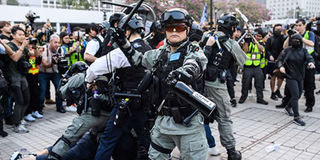Muzzled tale of China’s Uyghur Muslims

A police officer holds his baton as his colleagues detain a man during a rally in Hong Kong on December 22, 2019 to show support for the Uyghur minority in China. PHOTO | ANTHONY WALLACE | AFP
What you need to know:
- The government has started remedial programmes within the Uyghur communities aimed at empowering them through education.
- Radicals within the region have taken advantage of this by blaming Beijing for the natural harsh conditions to advance their political agenda and ambitions.
The way Western media recently handled two exposés on China’s Uyghur Muslims showed how bias leads them to tell half-truths for their interests.
Last November, many Western media houses ran with a story on a revelation that training camps run by the Chinese government in Xinjiang province were alleged prison camps.
Before the dust could settle on the buzz created by this claim, an English language documentary, “Fighting Terrorism in Xinjiang”, aired on China’s state broadcaster CGTN last month, unprecedentedly exposing the trauma that violent terrorism and religious extremism have brought to the region.
As expected, this did not get as much as a footnote mention in the Western media — even though the documentary garnered considerably extensive attention on social media globally.
Western media and politicians, who always seem to never miss an opportunity to comment on Xinjiang, ironically went silent.
SIEVE INFORMATION
Since we are living in unprecedented times where we are being bombarded with chunks of information from all directions, it’s advisable to sift carefully and objectively through whatever we come across as we navigate the unprecedented waters of fake news.
In this regard, it would be as unwise to rely on Western media as it would be to do so with Chinese-controlled outlets.
To wrap our minds around what is really going on in Xinjiang, let’s look at some undisputed, albeit muzzled, facts about the region.
The region consists of the north and south basins divided by the Tian Shan mountain range. Both basins are predominantly deserts, so, all the ethnic groups have to live along the oasis by the mountainside.
The south basin has 9.2 million people, whereby 90 per cent are Uyghurs. The north basin has 10.5 million people with only two million Uyghurs (20 per cent).
There are also six million Han Chinese and a million Kazakhs. The rest — about three million — live in the non-basin Ghulja region and are predominantly Kazakhs.
HARSH ENVIRONMENT
Despite Xinjiang’s diverse ethnic composition, 80 per cent of the Uyghurs live along the oasis in the south basin.
Compared to the north basin, the south basin is among the most isolated places in the world. It is surrounded by the Kun Lun mountain ranges, the Himalayas, Pamir Plateau and Tian Shan mountain ranges. All the mountains are over 5,000 metres high.
This means that even with the latest technology, it is extremely difficult to connect roads to neighbouring regions and most people here seldom leave the basin because its topography makes it expensive to travel outside.
The south basin also has an extreme desert climate, which is harsh if compared to the north basin and the Ghulja region since it’s characterised by literally zero rainfall, very hot summers and extremely cold winters with large temperature differences between the two seasons.
Young educated Uyghur people would rather leave their hometown and move to the north, the capital Urumuqi, or the rest of China for better opportunities than stay here.
Most of the remaining people are less educated. Faced with a harsh environment and limited resources, most of them find solace in religion, creating a fertile breeding ground for radicalisation.
WEST GOES MUM
To counter this, and in its efforts to keep far-flung areas abreast of the development level attained by urban centres, the government has started remedial programmes within the Uyghur communities aimed at empowering them through education and training.
Sadly, however, these have now fallen victim to Western propaganda.
History has proven time and again that if you are poor, miserable, jobless and religious, you might also convert to extreme religion.
Radicals within the region have taken advantage of this by blaming Beijing for the natural harsh conditions to advance their political agenda and ambitions.
Surprisingly, the West, which has waged war across the globe in its spirited ‘war on terror’, seems to have turned a blind eye to the terrorist activities in Xinjiang.
With China gaining muscle as an economic power with growing global influence, the West sees it as a threat or enemy.
WAR ON TERROR
Since the extremist organisations in Xinjiang are enemies to China, the West seems to have found a friend in them — in a classic enemy of my enemy is my friend case.
The global war on terror will not be won if we decide which terrorists to fight and which ones to go to bed with.
The threat posed to China by religious extremists is as real as that which the rest of the world faces from terrorists.
China, therefore, needs support in its fight against extremists and not choreographed attacks based on unsubstantiated claims.
Mr Opali is a freelance journalist. [email protected].





